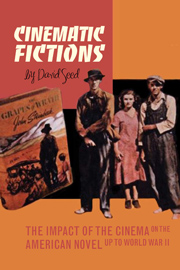Book contents
- Frontmatter
- Contents
- Introduction
- 1 Beginnings
- 2 Modernist Experiments: Gertrude Stein and Others
- 3 H.D. and the Limits of Vision
- 4 Ernest Hemingway: The Observer's Visual Field
- 5 Success and Stardom in F. Scott Fitzgerald
- 6 William Faulkner: Perspective Experiments
- 7 John Dos Passos and the Art of Montage
- 8 Dreiser, Eisenstein and Upton Sinclair
- 9 Documentary of the 1930s
- 10 John Steinbeck: Extensions of Documentary
- 11 Taking Possession of the Images: African American Writers and the Cinema
- 12 Into the Night Life: Henry Miller and Anaïs Nin
- 13 Nathanael West and the Hollywood Novel
- Bibliography
- Index
13 - Nathanael West and the Hollywood Novel
- Frontmatter
- Contents
- Introduction
- 1 Beginnings
- 2 Modernist Experiments: Gertrude Stein and Others
- 3 H.D. and the Limits of Vision
- 4 Ernest Hemingway: The Observer's Visual Field
- 5 Success and Stardom in F. Scott Fitzgerald
- 6 William Faulkner: Perspective Experiments
- 7 John Dos Passos and the Art of Montage
- 8 Dreiser, Eisenstein and Upton Sinclair
- 9 Documentary of the 1930s
- 10 John Steinbeck: Extensions of Documentary
- 11 Taking Possession of the Images: African American Writers and the Cinema
- 12 Into the Night Life: Henry Miller and Anaïs Nin
- 13 Nathanael West and the Hollywood Novel
- Bibliography
- Index
Summary
The rise of the Hollywood film industry was closely followed from 1912 onwards by a growing number of novels engaging with what one critic has described as the ‘hyperbolic cultural symbol’ of the USA as a whole. For John Springer the Hollywood novel – a broad category that included romance, satire, and crime fiction – revolved around a central theme, the ‘confusion of illusion and reality’. My focus in this chapter, however, is not to repeat such surveys but rather to examine those Hollywood novels which appropriate or imitate the very representational techniques of the film medium they are describing. Again and again we shall see characters being drawn in to the complex process of commodification within the Hollywood system.
One of the earliest novels to do this was Harry Leon Wilson's Merton of the Movies (1922), which was greatly admired by Gertrude Stein, who made a point of visiting Wilson during her 1935 visit to Hollywood. In Everybody's Autobiography she described it as the ‘best description of America that has ever been done’ and, as if that wasn't enough, the ‘best book about twentieth century [sic] American youth’. Wilson's novel describes the experiences of an Illinois assistant in a clothes shop whose obsession with film leads him to move to Hollywood where, after many setbacks reducing him to the brink of starvation, he finally achieves success as a movie star.
- Type
- Chapter
- Information
- Cinematic FictionsThe Impact of the Cinema on the American Novel up to World War II, pp. 258 - 280Publisher: Liverpool University PressPrint publication year: 2009



